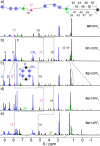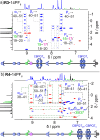Controlled assembly of rotaxane translational isomers using dual molecular pumps
- PMID: 40595599
- PMCID: PMC12216197
- DOI: 10.1038/s41467-025-61364-2
Controlled assembly of rotaxane translational isomers using dual molecular pumps
Abstract
The ability to control the relative motion between different components of molecules with precision is a cornerstone of synthetic nanotechnology. Mechanically interlocked molecules such as rotaxanes offer a platform for exploring this control by means of the positional manipulation of their components. Here, we demonstrate the use of a molecular dual pump to achieve the assembly of translational isomers with high efficiency and accuracy. By harnessing pumping cycles, rings can be guided selectively along a molecular axle, resulting in two sets of distinct translational isomers of [2]- and [3]rotaxanes. These isomers, produced in high yields, are characterized by mass spectrometry in addition to one- and two-dimensional nuclear magnetic resonance spectroscopy, which collectively reveal the location of the rings in the rotaxanes. Nuclear Overhauser effect spectroscopy confirms the spatial localization of rings, while diffusion ordered spectroscopy measurements quantifies the differences in hydrodynamic properties between the rotaxanes. This research supports the status of molecular pumps as a robust tool for precise nanoscale assembly, while advancing the practice of molecular machinery at the frontiers of synthetic nanotechnology.
© 2025. The Author(s).
Conflict of interest statement
Competing interests: The authors declare no competing interests.
Figures








Similar articles
-
Intravenous magnesium sulphate and sotalol for prevention of atrial fibrillation after coronary artery bypass surgery: a systematic review and economic evaluation.Health Technol Assess. 2008 Jun;12(28):iii-iv, ix-95. doi: 10.3310/hta12280. Health Technol Assess. 2008. PMID: 18547499
-
Signs and symptoms to determine if a patient presenting in primary care or hospital outpatient settings has COVID-19.Cochrane Database Syst Rev. 2022 May 20;5(5):CD013665. doi: 10.1002/14651858.CD013665.pub3. Cochrane Database Syst Rev. 2022. PMID: 35593186 Free PMC article.
-
Systemic pharmacological treatments for chronic plaque psoriasis: a network meta-analysis.Cochrane Database Syst Rev. 2021 Apr 19;4(4):CD011535. doi: 10.1002/14651858.CD011535.pub4. Cochrane Database Syst Rev. 2021. Update in: Cochrane Database Syst Rev. 2022 May 23;5:CD011535. doi: 10.1002/14651858.CD011535.pub5. PMID: 33871055 Free PMC article. Updated.
-
Magnetic resonance perfusion for differentiating low-grade from high-grade gliomas at first presentation.Cochrane Database Syst Rev. 2018 Jan 22;1(1):CD011551. doi: 10.1002/14651858.CD011551.pub2. Cochrane Database Syst Rev. 2018. PMID: 29357120 Free PMC article.
-
Technological aids for the rehabilitation of memory and executive functioning in children and adolescents with acquired brain injury.Cochrane Database Syst Rev. 2016 Jul 1;7(7):CD011020. doi: 10.1002/14651858.CD011020.pub2. Cochrane Database Syst Rev. 2016. PMID: 27364851 Free PMC article.
References
-
- Eliel, E. L. Stereochemistry of Organic Compounds (Wiley, 1994).
-
- Leigh, J. Principles of Chemical Nomenclature A Guide to IUPAC Recommendations2011Edition:A. Guide to IUPAC Recommendations2011 Edition (The Royal Society of Chemistry, 2011).
-
- Favre, H. A. & Powell, W. H. Nomenclature of Organic Chemistry (The Royal Society of Chemistry, 2013).
-
- Oki, M. Reactivity of conformational isomers. Acc. Chem. Res.17, 154–159 (1984).
Grants and funding
LinkOut - more resources
Full Text Sources

